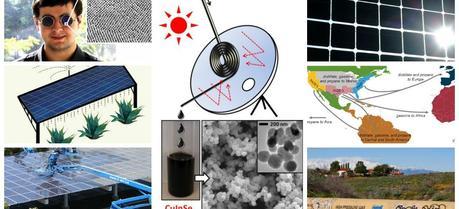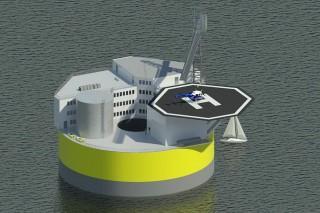
Solar deployment exceeds wind in 2013 and provides nearly 22% of new generating capacity added in 2013 in the U.S.; scientists look for possible ways to reduce glare from solar panels, use solar panels to make more solar panels and combine solar with biofuel. Solar and natural gas account for most of the new generating capacity in the U.S. in 2013, oil production and oil exports increase. We have collected all these stories and more of the most important energy news of the past month conveniently in one place for you to read.
Solar Energy
More new solar photovoltaic generating capacity was added throughout the globe than wind energy in 2013, according to the Clean Energy Trends 2014 report issued by clean-tech research and advisory firm Clean Edge, Inc. Last year also marked a significant transition in the history of clean energy: for the first time since Clean Edge began tracking global markets in 2000, the world installed more new solar PV generating capacity, 36.5 gigawatts, than wind power (35.5 GW). Record levels of new solar deployment in China, Japan, and the U.S. combined with a down year in the wind industry to create this unprecedented crossover. In contrast to 2011 and 2012, when PV panel costs plummeted more than 20 percent in both years, prices held nearly steady last year, dropping slightly to $2.50 per watt installed.
In the U.S. natural gas-fired power plants accounted for just over 50% of new generating capacity added in 2013, while solar provided nearly 22%, a jump up from less than 6% in 2012, coal provided 11% and wind nearly 8%, according to EIA estimates. Solar photovoltaic added 2,193 MW of capacity in 2013, continuing the trend of the past few years of strong growth, helped in part by falling technology costs as well as aggressive state renewable portfolio standards (RPS) and continued federal investment tax credits. Nearly 75% of the capacity added was located in California, followed by roughly 10% in Arizona.
Meanwhile, two studies look into ways to reduce glare from solar panels. A group of UC Irvine scientists has created a patterned polymer material capable of eliminating glare. To do it, the group etched a repeating pattern of cones modeled on moth eyeballs at the nanoscale on Teflon and other nonstick surfaces. They then applied a thin layer of gold over the cones and the shine from the gold and any light reflecting onto it was all but obliterated. The material is also highly hydrophobic, meaning it repels liquids.
The most popular posts in April, 2014
1. Scientists Suggest Planting Biofuel Crops on Solar Farms
2. Flexible Thermoelectric Generator Turns Body Heat Into Electricity
3. Scientists Use Airplane to Detect Methane From Fracking
4. MIT Proposes Tsunami-Proof Floating Nuclear Plants
5. U.S. Navy Christens New All-Electric Stealth Destroyer
Scientists at Loughborough University have also found a way to reduce solar panel glare while simultaneously increasing the efficiency of a solar installation. They developed a multi-layer anti-reflection coating for glass surfaces, which reduces the sun’s reflection from photovoltaic panels while at the same time improving their efficiency. Researchers believethat the new coating will be attractive to solar panel manufacturers. It is applied using the same technology as that used for depositing anti-reflection coatings on spectacles. The design consists of only four alternate layers of zirconium oxide and silicon dioxide and the whole stack is less than 300 nm thick. These materials were chosen because they are abundant and low cost.
Researchers at Oregon State University have discovered a way to tap the sun not only as a source of power, but also to directly produce the solar energy materials that make this possible. The work is based on the use of a “continuous flow” microreactor to produce nanoparticle inks that make solar cells by printing. In this process, simulated sunlight is focused on the solar microreactor to rapidly heat it, while allowing precise control of temperature to aid the quality of the finished product. “Our system can synthesize solar energy materials in minutes compared to other processes that might take 30 minutes to two hours,” said Chih-Hung Chang, a professor of chemical engineering at Oregon State University, and lead author on the study. “This gain in operation speed can lower cost.”
Another idea for making solar energy more efficient is to combine solar with biofuel. Growing agave and other carefully chosen biofuel crops amid photovoltaic panels could allow solar farms not only to collect sunlight for electricity but also to produce crops for biofuels, according to new computer models by Stanford scientists. Photovoltaic solar farms run on sunlight, but water is required to remove dust and dirt from the panels to ensure they operate at maximum efficiency. Water is also used to dampen the ground to prevent the buildup and spread of dust. Crops planted beneath the solar panels would capture the runoff water used for cleaning the PV panels, thus helping to optimize the land. The plants’ roots would also help anchor the soil and their foliage would help reduce the ability of wind to kick up dust.
Oil and Natural Gas
Natural gas, along with solar energy, accounted for most of the new generating capacity added in 2013 in the U.S. According to EIA, natural gas-fired power plants accounted for just over 50% of new power plant capacity additions and solar provided nearly 22%, a jump up from less than 6% in 2012.
Natural gas capacity additions were less than in 2012, as 6,861 MW were added in 2013, compared to 9,210 MW in 2012. The capacity additions came nearly equally from combustion turbine peaker plants, which generally run only during the highest peak-demand hours of the year, and combined-cycle plants, which provide intermediate and baseload power.
U.S. tight oil production averaged 3.22 million barrels per day (MMbbl/d) in the fourth quarter of 2013, according to U.S. Energy Information Administration estimates. This level was enough to push overall crude oil production in the United States to an average of 7.84 MMbbl/d, 10.4% of total world production, up from 9% in the fourth quarter of 2012. Exports of petroleum products from the United States averaged 3.5 million barrels per day (bbl/d) in 2013, 10% more than in 2012.
According to a report from the National Research Council, a changing climate is increasing the accessibility of U.S. Arctic waters to commercial activities such as shipping, oil and natural gas development, and tourism, raising concern about the risk of oil spills. A full suite of proven oil response tools is needed to address potential oil spills in U.S. Arctic waters, but not all of them are readily available. While much is known about both oil behavior and response technologies in ice-covered environments, there are areas where additional research would enable more informed decisions about the most effective response strategies for different Arctic spill situations, the report adds.
As for the natural gas leaks, it turns out that bacteria could mop them up before the gases are released into the atmosphere—according to new research from the University of East Anglia. Findings of a new study show how a single bacterial strain found in soil and other environments around the world can grow on both the methane and propane found in natural gas.
It was originally thought that the ability to metabolize methane and other gaseous alkanes such as propane was carried out by different groups of bacteria. This new finding is important because it means that one type of bacteria can mop up the components of natural gas very efficiently and reduce pollution. The findings could help mitigate the effects of the release of greenhouse gases to the atmosphere from both natural gas seeps in the environment and those arising from man-made activity such as fracking and oil spills.
In another study, scientists at Rice University have created a nanoscale detector that checks for and reports on the presence of hydrogen sulfide in crude oil and natural gas while they’re still in the ground. Limited exposure to hydrogen sulfide causes sore throats, shortness of breath and dizziness, according to the researchers. The human nose quickly becomes desensitized to hydrogen sulfide, leading to an inability to detect higher concentrations.
To detect hydrogen sulfide, the scientists used thermally stable, soluble, highly mobile, carbon black-based nanoreporters modified to look for hydrogen sulfide and report results immediately upon their return to the surface. When exposed to hydrogen sulfide, the nanoparticles’ fluorescent properties immediately change. When pumped out of a production well, the particles can be analyzed with a spectrometer to determine the level of contamination.
This month in photos: March 2014

Dam of Limberg II pumped storage plant, Austria. (Credit: Voith)

This illustration shows a possible configuration of a floating offshore nuclear plant, based on design work by Jacopo Buongiorno and others at MIT’s Department of Nuclear Science and Engineering. Like offshore oil drilling platforms, the structure would include living quarters and a helipad for transportation to the site. (Credit: Jake Jurewicz / MIT-NSE)

Quantum dot LSC devices under ultraviolet illumination. (Credit: Los Alamos National Laboratory)

SOLAR-JET for the first time demonstrates the entire production path of solar kerosene. (Credit: SOLAR-JET project)

A thermoelectric generator developed as a wristband. The generator can be easily curved along with the shape of human body. (Credit: KAIST)

A test of a Makani airborne wind energy design. (Credit: Kathy F. Atkinson /
Makani)

